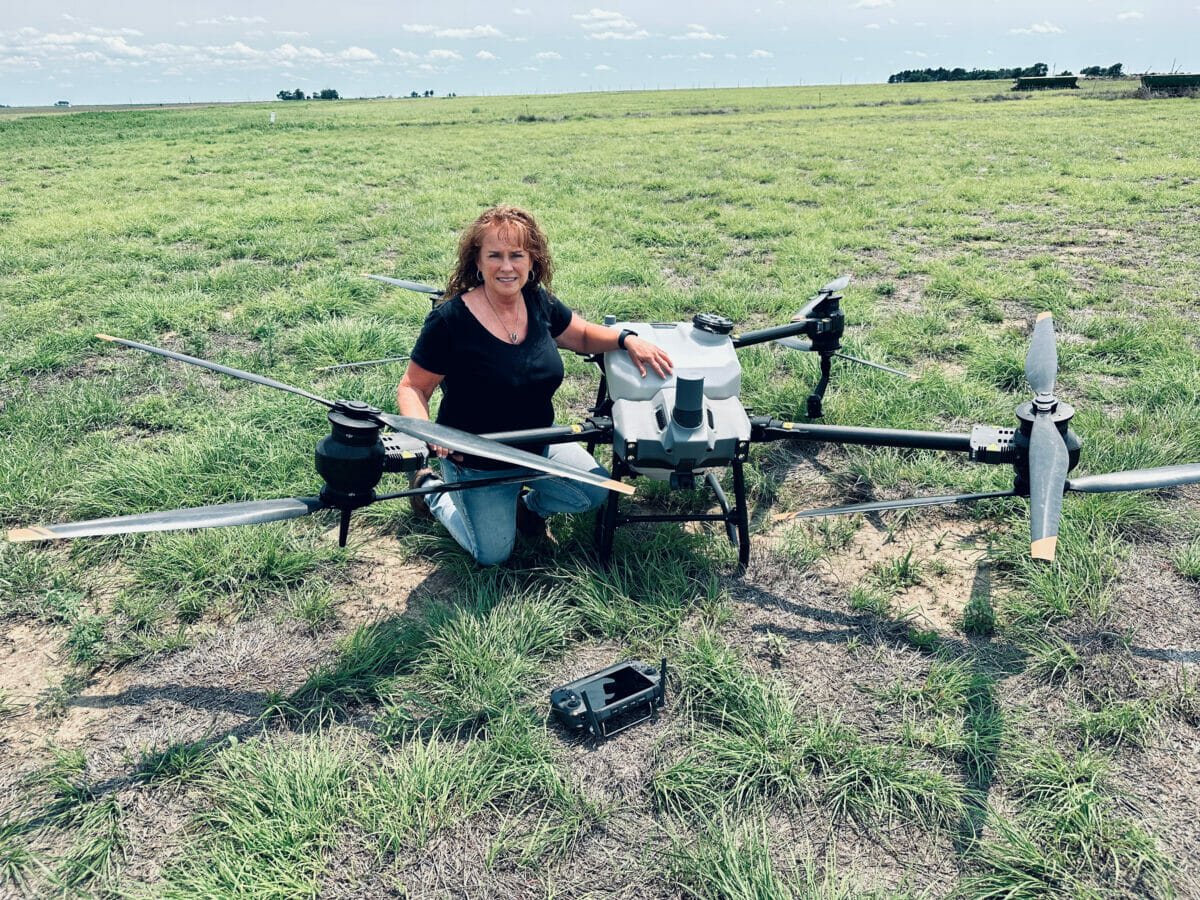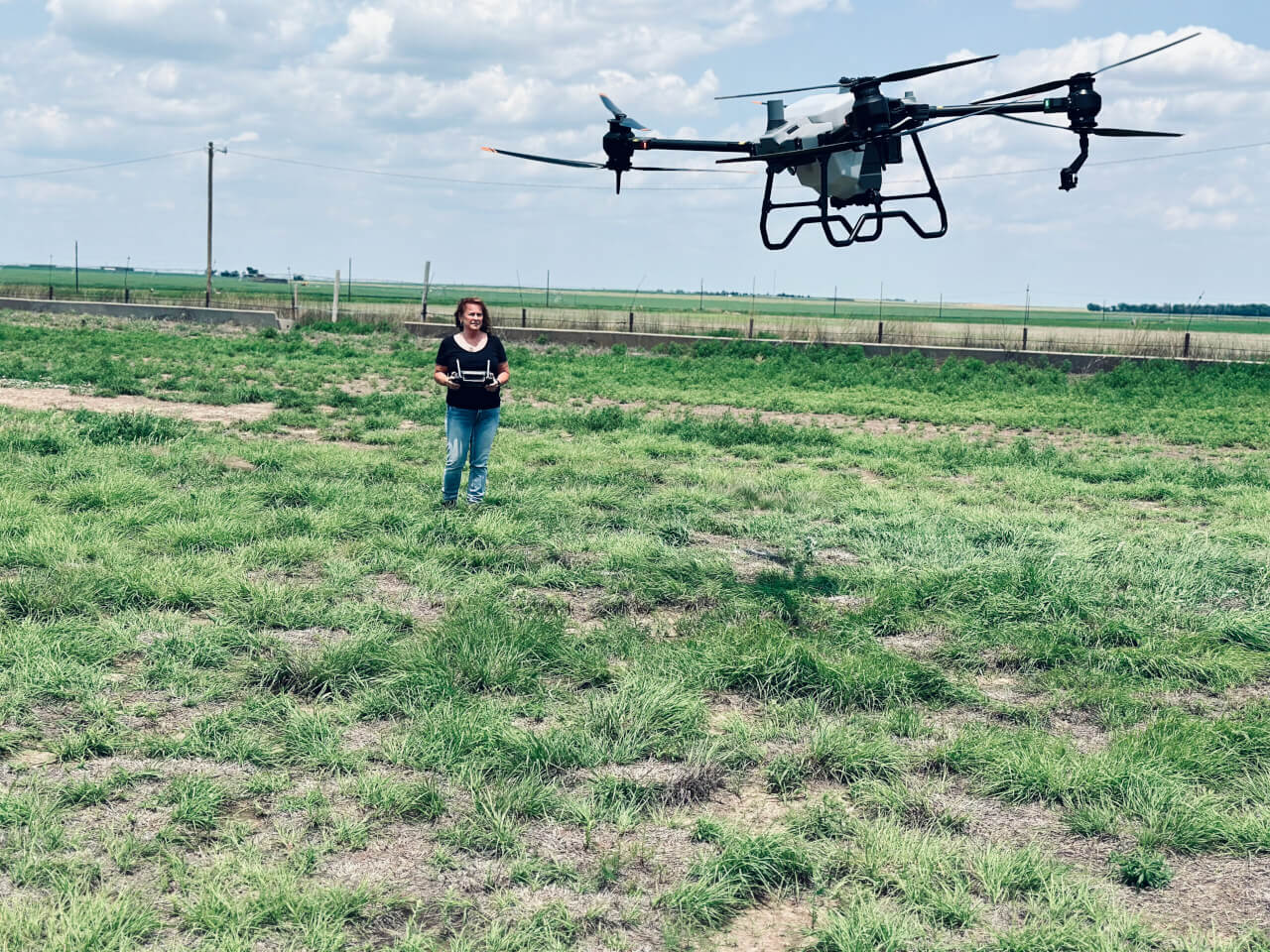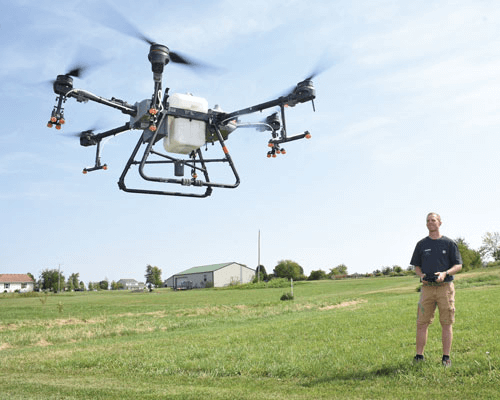Welcome to the Next Generation of Agricultural Drones
The newest crop of drones promises farmers greater sustainability and autonomy, while drawing interested newcomers into the field.
Welcome to the Next Generation of Agricultural Drones
The newest crop of drones promises farmers greater sustainability and autonomy, while drawing interested newcomers into the field.

Tracye Beer changed careers to become an agricultural drone pilot. Photography by Gerald Beer
After 32 years as an assistant paralegal, Tracye Beer is launching a new career—as an agricultural drone pilot.
When the 57-year-old lost her job back in February, she wanted to prioritize spending more time on her family’s fourth-generation farm near Guymon, in the Oklahoma panhandle. As an experienced flier who’d obtained her sport pilot’s license back in high school, seeing drones at an agricultural training seminar “really piqued my interest,” she recalls.
Beer realized that unmanned aerial spraying systems (UASS), designed to haul and disperse tanks of herbicide, fertilizer, and seeds across vast fields, could fill a job once reserved for large-rig ground sprayers and crop dusters. Using her family’s 3,000-acre corn, wheat, and grain fields as a training ground, “it was the perfect opportunity to explore something new,” she says—and help wean the farm off conventional spraying methods.
In addition to making operations more efficient, spray drones lighten the environmental impacts of agriculture through precise aerial applications and a drastically lighter footprint. And they’re also helping farmers boost their bottom line while luring a fresh crop of tech- and aviation-minded peers into a shrinking profession.
The technology also gives growers a new level of autonomy, says Beer, who’s started a drone spraying business with her sister. “When there’s a [crop] issue, you need to get someone in to spray, and you need it done now—along with everyone else in the county,” she adds. “But rather than having to get in line and wait [for a plane], you can fly your drone immediately.”
Besides, flying one is an amazing experience, she says. Despite its 12-foot wingspan, the dragonfly-like contraption zooms, hovers, and turns on a dime. “It’s so maneuverable and graceful.”

According to the Association for Uncrewed Vehicle Systems International (AUVSI), a nonprofit trade group, agriculture could soon account for 80 percent of the global commercial drone market.
Governmental regulations, including environmental restrictions on aerial spraying, largely dictate adoption. In drone-friendly China, UASS use has soared, particularly on small farms where large mechanical equipment is either too costly or impractical. On the other hand, France—which has recently seen a significant jump in herbicide, and pesticide use—restricts drones from spraying over concerns about drifting mist. That’s similar to Canada, where the Pest Management Regulatory Agency currently limits them to research purposes.
In the US, both the Federal Aviation Administration (FAA) and Environmental Protection Agency (EPA) have approved remote aerial spraying by licensed drone operators. That’s liberated many row crop farmers from the costly burden of hiring planes and helicopters, says Taylor Moreland, owner of Agri Spray Drones, a Missouri-based agricultural drone dealer.
A large share of Moreland’s customers are small-scale Midwestern corn growers with 200- to 500-acre farms. With tassels growing 10 feet or higher, ground spraying isn’t an option, he says, so most farms typically hire aircraft to blanket crops with herbicide, fungicide, and pesticide. “The demand for those [services] is high, although the supply of pilots isn’t growing,” he says. “So drones are filling that gap.”
Learn more
Is sheep wool an effective fertilizer?
The Agras T40—Beer’s new baby and the biggest model Moreland offers—is a flying workhorse. Capable of hauling 10 gallons of herbicide or 115 pounds of fertilizer or seeds on a single charge, it can cover up to eight acres before boomeranging back to base for a battery swap and resupply.
A full package, which includes spare batteries, recharger, and tanks, as well as in-house training and FAA licensing, runs about $35,000. Compared to the trucks, tractors, and half-a-million-dollar combines required in commodity farming, that’s a much more reasonable investment for small- and medium-scale growers, says Moreland.
Still, there are only so many acres that one drone can blanket with any efficiency. Along with corn, broad-acre fields growing wheat, soybeans, and barley often measure in the thousands—or even tens of thousands—of acres. Here, high-clearance ground rigs are standard equipment: Using 120-foot booms, these million-dollar sprayers blanket fields with chemicals using overlapping, redundant nozzles to ensure maximum coverage.
Weeds, however, tend to form in isolated patches, rather than across entire fields, says Terry Aberhart, a third-generation farmer in Langenburg, in eastern Saskatchewan. With herbicides accounting for a big chunk of operating costs on his family’s 18,000-acre wheat and canola farm, “it seems ludicrous to have to carpet bomb the whole field,” he says.
Those vast fields have been a testing ground for Canada-based Precision AI’s autonomous smart drones. Rigged with high-resolution cameras that track detail down to the half-pixel, the UASSs can identify any of the 19,000 plants stored in its database, then zap away weeds with 96 percent accuracy. And because the aerial sprayers hover mere feet above their mark, “we’ve drastically reduced our chemical use [while] increasing overall yields,” says Aberhart.
While each drone has a spray width of 21 feet, matching the scaled efficiency of a ground rig requires flying multiple units, says Warren Bills, vice president of business development for agriculture at Precision AI. Yet, even with the $100,000 base price, swarming three in tandem “gives you half the boom width of a high-clearance sprayer” at a third of the price, he says.
The aerial application also relieves fields of heavy, large-wheeled machinery, Bills adds, which can compact soil, trample crops, and reduce yields by nearly 15 percent. “When you take crop protection to the air, that’s where you see some of the most favorable economics.”
Although AI-enabled drones can make operations more efficient, he dismisses the notion that they threaten farming jobs. Surveying crops and scouting weeds are time-consuming tasks best left to automation, says Bills. Rapid surveillance and instant plant identification give agronomists more leeway in developing effective prescriptions and timely strategies—important considerations given the short, seasonal windows farmers have for managing weeds, disease, and pests.
“Rather than spending eight hours a day walking a field saying, ‘Oh, you’ve got these five weeds,’ there’re so many [other] decisions that they could be focusing on,” says Bills.

Spray drones also add a job to small-scale farms and farming communities, says Agri Spray’s Moreland. The lower financial bar helps keep farmers in business, and it is luring some with a farming background back to rural areas.
The technology has also drawn a younger crowd to the field, including a 24-year-old TikToker posting her aerial escapades under the handle “CarolineTXFarmer” and a 21-year-old pilot in high demand for her accuracy on farms throughout Mexico. Beer, from Oklahoma, recalls that, in addition to several women among the 50 or so students in her training and certification class, there was also a 14-year-old accompanied by his grandfather. (The FAA’s minimum age for drone pilot certification is 16.)
As the industry continues to grapple with steep operating expenses, labor shortages, and the increasing impact of climate change, drones show promising potential to enhance efficiency. Yet researchers encourage a cautious approach to implementing autonomous technology in agriculture, citing the implications of inadequate cyber-security and other potential risks to the global food system, as well as weak internet penetration and cost barriers deepening the digital divide.
Agri Spray’s Moreland acknowledges the safety concerns, although limited speeds and flight times are obvious deterrents, he notes, adding that “the information they collect is pretty minimal.” And Bills points out that drones operate independently, without an internet or data connection; even Precision AI’s data-heavy computing is all processed onboard. (That’s also practical, he notes, as large swaths of rural Canada have poor broadband and mobile coverage.)
read more
Rural Farmers Are Desperate for Broadband Internet
Meanwhile, the plummeting cost of basic agricultural drones seems to be pushing up demand. Like their Chinese counterparts, small-scale growers in India are abandoning hand-held sprayers for UASSs, often hiring or renting them from local service providers. Their agility also makes the technology practical for farms in a range of terrains, including steep slopes, forested areas, and wetland regions.
As for Beer, she has no regrets about her midlife leap. “Sometimes, it takes getting pushed out of the nest to soar,” she says. “This was a complete career change, but I see a great future ahead.”
Follow us
This work is licensed under a Creative Commons Attribution-NoDerivatives 4.0 International License.
Want to republish a Modern Farmer story?
We are happy for Modern Farmer stories to be shared, and encourage you to republish our articles for your audience. When doing so, we ask that you follow these guidelines:
Please credit us and our writers
For the author byline, please use “Author Name, Modern Farmer.” At the top of our stories, if on the web, please include this text and link: “This story was originally published by Modern Farmer.”
Please make sure to include a link back to either our home page or the article URL.
At the bottom of the story, please include the following text:
“Modern Farmer is a nonprofit initiative dedicated to raising awareness and catalyzing action at the intersection of food, agriculture, and society. Read more at <link>Modern Farmer</link>.”
Use our widget
We’d like to be able to track our stories, so we ask that if you republish our content, you do so using our widget (located on the left hand side of the article). The HTML code has a built-in tracker that tells us the data and domain where the story was published, as well as view counts.
Check the image requirements
It’s your responsibility to confirm you're licensed to republish images in our articles. Some images, such as those from commercial providers, don't allow their images to be republished without permission or payment. Copyright terms are generally listed in the image caption and attribution. You are welcome to omit our images or substitute with your own. Charts and interactive graphics follow the same rules.
Don’t change too much. Or, ask us first.
Articles must be republished in their entirety. It’s okay to change references to time (“today” to “yesterday”) or location (“Iowa City, IA” to “here”). But please keep everything else the same.
If you feel strongly that a more material edit needs to be made, get in touch with us at [email protected]. We’re happy to discuss it with the original author, but we must have prior approval for changes before publication.
Special cases
Extracts. You may run the first few lines or paragraphs of the article and then say: “Read the full article at Modern Farmer” with a link back to the original article.
Quotes. You may quote authors provided you include a link back to the article URL.
Translations. These require writer approval. To inquire about translation of a Modern Farmer article, contact us at [email protected]
Signed consent / copyright release forms. These are not required, provided you are following these guidelines.
Print. Articles can be republished in print under these same rules, with the exception that you do not need to include the links.
Tag us
When sharing the story on social media, please tag us using the following: - Twitter (@ModFarm) - Facebook (@ModernFarmerMedia) - Instagram (@modfarm)
Use our content respectfully
Modern Farmer is a nonprofit and as such we share our content for free and in good faith in order to reach new audiences. Respectfully,
No selling ads against our stories. It’s okay to put our stories on pages with ads.
Don’t republish our material wholesale, or automatically; you need to select stories to be republished individually.
You have no rights to sell, license, syndicate, or otherwise represent yourself as the authorized owner of our material to any third parties. This means that you cannot actively publish or submit our work for syndication to third party platforms or apps like Apple News or Google News. We understand that publishers cannot fully control when certain third parties automatically summarize or crawl content from publishers’ own sites.
Keep in touch
We want to hear from you if you love Modern Farmer content, have a collaboration idea, or anything else to share. As a nonprofit outlet, we work in service of our community and are always open to comments, feedback, and ideas. Contact us at [email protected].by Naoki Nitta, Modern Farmer
June 19, 2023
Modern Farmer Weekly
Solutions Hub
Innovations, ideas and inspiration. Actionable solutions for a resilient food system.
ExploreExplore other topics
Share With Us
We want to hear from Modern Farmer readers who have thoughtful commentary, actionable solutions, or helpful ideas to share.
SubmitNecessary cookies are absolutely essential for the website to function properly. This category only includes cookies that ensures basic functionalities and security features of the website. These cookies do not store any personal information.
Any cookies that may not be particularly necessary for the website to function and are used specifically to collect user personal data via analytics, ads, other embedded contents are termed as non-necessary cookies.
This is really a great advancement of agriculture and a good sign for the future of agriculture. In the future, hopefully we can see drones watering plants, sowing seeds, sprinkling fertilizers, and so on. This is great.
Great. Can training be extended to Nigerian farmers?
For a true Ag revolution to take place, a cheaper, cleaner, and safer alternative must be developed for full-scale Ag spray aircraft. 10-gallon spray drones are great to spray small areas, but with a narrow swath and low airspeed, they can’t replace an AirTractor, yet still require Part 137 certification and commercial certificate to operate legally in the US. That is what we are trying to fix with Edison Aerospace – create a full-scale electric, remotely operated Ag spray aircraft, carrying 200 gallons on the smallest model. This will be the first viable alternative for the AirTractor in the coming… Read more »
Yes, nice development
Congra Tracye to your new future.
Where do I get training & what is your recommendation for new trainee?
Spot spraying doesn’t work !!!
no more spraying toxic chemicals!